A “Milestone” Exhibition: Place, Nations, Generations, Beings Celebrates 200 Year of Indigenous Arts at Yale
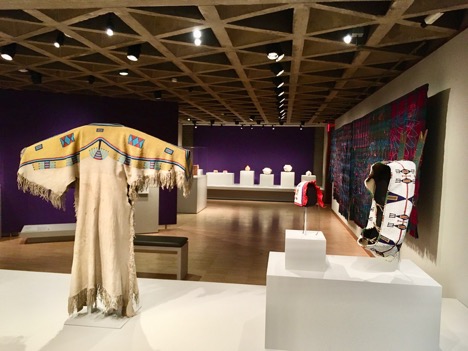
Yale administrative and campus leaders are hailing the recently opened, student-curated exhibition, Place, Nations, Generations, Beings: 200 Years of Indigenous North American Art. The culmination of three years of work by student curators—Katherine Nova McCleary (Little Shell Chippewa-Cree) ’18; Leah Tamar Shrestinian, ’18; and Joseph Zordan (Bad River Ojbiwe) ’19—this show draws from across Yale’s many museum and library holdings to showcase incomparable works of Native American creative production. From contemporary photography to nineteenth-century weavings, from boarding school drawings to late twentieth-century ceramics, this show marks, according to Yale University Art Gallery Director Stephanie Wiles, a “milestone in the display and interpretation of Native American art at Yale.”
The exhibition represents a number of firsts. Not only is it the first major show of Native American art to be held at the University Art Gallery, it also brings together over ninety pieces of work from across the extended Yale campus community. Such intra-institutional partnerships are less common than many realize, and the curators successfully navigated multiple campus collections in developing the exhibition. From the Beinecke Rare Book and Manuscript Library to the Yale Peabody Museum of Natural History, the curators accessed, analyzed, and often re-interpreted the collection of Native arts within these institutions.
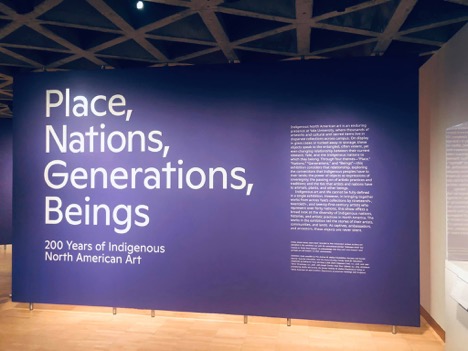
Like the extended Native American Cultural Center community on campus, the exhibition consists ofa wide variety of Indigenous voices and experiences. It highlights this diversity from over forty respective Indigenous nations and does so through more than ninety artworks from the early 19th century to the present. It showcases basketry, beadwork, drawings, photography, pottery, textiles, and wood carving by prominent artists such as Maria Martinez (P’ohwhóge Owingeh [San Ildefonso Pueblo]), Marie Watt (Seneca), M.F.A. ‘96, and Will Wilson (Diné [Navajo]), among others. Guided by the four themes in its title, the exhibition investigates the connections that Indigenous peoples have to their lands; the power of objects as expressions of sovereignty; the passing on of artistic practices and traditions; and the relationships that artists and nations have to animals, plants, and cosmological beings. The objects on view on the Fourth Floor of the University Art Gallery work to contribute to the larger narrative of American art and act as touchstones for further partnerships with Indigenous nations.
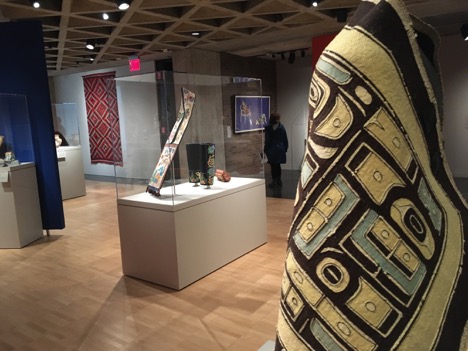
Partnership and collaboration are, indeed, inherent to the curatorial methods on display. As the curators relay in the accompanying catalog, “Our gratitude also goes to the revolutionary Indigenous scholars, activists, and community members… whose work has inspired us, including… those who served on the Advisory Council on Native Arts and Cultures.” The Advisory Council, which was formed to provide formal recommendations to respective campus institutions on how best to continue the momentum established by this exhibition, included scholars, artists, curators, and tribal leaders from across Native North America, including leaders from each of Connecticut’s federally-recognized tribes: Joshua Carter, Manager of Tribal and Native American Preference at the Mashantucket Pequot Tribal Nation, and Melissa Tantaquidgeon Zobel, Medicine Woman and Tribal Historian, Mohegan Tribe. Additional council members included: Greg Hill (Kaneyn’kehaka, Six Nations of the Grand River Territory), Audain Senior Curator of Indigenous Art, National Gallery of Canada; Joe Horse Capture (A’aninin), Director of American Indian Initiatives, Minnesota Historical Society; Da-ka-xeen Mehner (Tlingit/N’ishga), Assistant Professor, Native Arts, University of Alaska, Fairbanks; Nancy Mithlo (Chiricahua Apache), Professor of Gender Studies, UCLA; Anya Montiel (Tohono O’odham), Assistant Professor, Art, University of Arizona; Patsy Phillips (Cherokee), Director, IAIA Museum of Contemporary Native Arts; Jami Powell (Osage), Associate Curator of Native American Art, Hood Museum, University of Dartmouth; Jolene Rickard (Tuscarora), Associate Professor, Director of the American Indian and Indigenous Studies Program, Cornell University; and Governor Brian Vallo, Pueblo of Acoma.
In addition to working with these and other Indigenous curators, scholars, and artists, the curators chose to open each of the respective entryways into the exhibit with works by regional artists, including a recent bowl by Mohegan carver Justin Scott whose untitled piece was given to the University in 2017 following more than a decade of negotiations between the Mohegan Nation and the campus community regarding the return of cultural objects. Affirming both this process of repatriation and the enduring presence of the region’s Indigenous nations, this piece and its accompanying entryway piece—a nineteenth-century basket by a once-known Mohegan artist—are framed by prominent land acknowledgements on each of the exhibition’s entrances. As McCleary and Shrestinian write in their extended catalog essay, “The curatorial approach we took… was deeply informed by the Mohegan Nation’s achievements and those of the other Indigenous nations who have long sought the return of their cultural and sacred items and the right to represent themselves as they wish to be represented.”
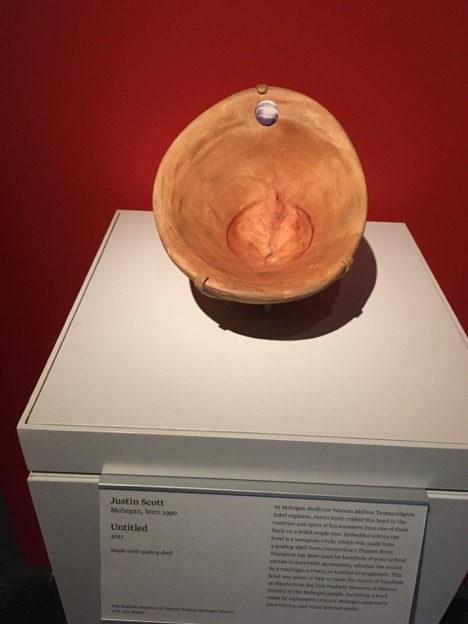
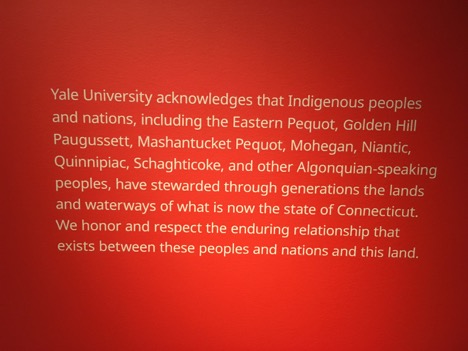
The exhibition will be on display at the Yale University Art Gallery until June 21, 2020.
For more, see:
https://artgallery.yale.edu/exhibitions/exhibition/place-nations-generat…
https://artgallery.yale.edu/publication/place-nations-generations-beings…
https://news.yale.edu/2019/11/11/shape-contour-and-respect-200-years-ind…